
Urbanization and Art Deco
One of the underlying influences on Art Deco styling was the slowly growing urbanization of the culture.
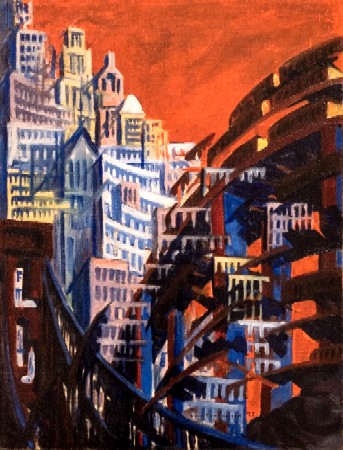
New York 59th Street Bridge, Painting by Louis Lozowick, 1922
Scott Beyer opines, "Art Deco is a quintessentially urban design style because of the characteristics described above: it celebrates technological progress, merges different global styles, has color and personality, and above all, shows a glamorous version of the city life." (Beyer, "Art Deco is Quintessentially Urban", The Market Urbanist website, gathered 3-20-25)
The Art Deco style liberated itself from the fanciful flourishes of previous design styles and embraced a modernistic simplication and progress. Modernism had been around before the style took hold in the 1920s. Modernists sought to simplify design to the point where it met their mantra "form follows function". Decorative elements were removed with hardcore Modernists atte,[tomg a complete break with past design styles. Art Deco embraced the notion that design needed modernization and simplification yet didn'tcompletely reject decoration. The New York Public Library website notes that the philosophy behind Art Deco designs changed over time.
Art Deco design exemplified opulent consumption, crass commercialism, and the acceleration of contemporary life summed up in the Futurist credo "Speed is beauty." Art Deco's greatest achievement, however, came in its mature phase [Streamline Moderne], when designers liberated the machine from long-standing artistic contempt." ("Art Deco: A Research Guide", New York Public Library website, gathered 11-24-24)
It could be argued that it was necessary for the machine, and the machine-made, to provide the things needed by those moving into the city following the first world war. This slow movement from the country to the cities began before the 1920s building during the Art Deco period as people embraced capitalism and moved to where money and industries were concentrated. "The Roaring Twenties saw increased urbanisation, as people flocked to cities in search of new opportunities. This led to a desire for modern and forward-thinking design that reflected the fast-paced lifestyle of the era. Art Deco embodied this". ("The History of Art Deco", Burgh Island website, gathered 3-25-25)
Rosalind Crone explains that after the first world war ended,
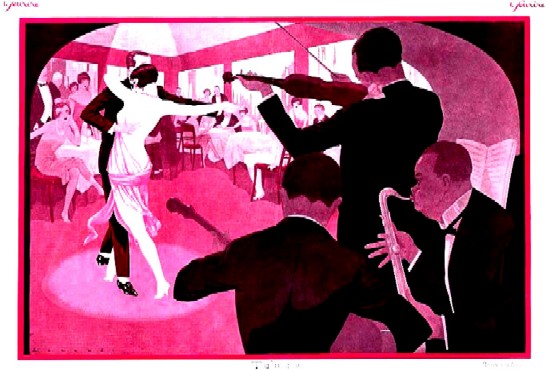
Tango, by Fabius Lorenzi, 1926, Art Deco Society of Los Angeles
music halls were joined and subsequently replaced by cinemas, dance halls and jazz clubs; existing urban transport networks were extended and new ones built to service growing numbers of commuters living in emerging suburbs; new forms of transport, notably cars, raised the tempo of city life; and the increase of white-collar employment, for women as well as men, swelled the ranks of the middle class and fueled new levels and forms of consumerism. While municipal authorities began to focus on 'town planning', urbanization and changing demographics collided with the artistic movement of modernism, generating new designs for urban living that promoted functionalism and hygiene. Finally, the city began to acquire a new dominance over rural life in many countries: it sucked in immigrants from the countryside who were in search of new employment opportunities; and new communications networks, often emanating from the city, promoted urban life and culture." (Crone, "Roaring Twenties? Europe in the interwar period", The Open University website, gathered 11-24-24)
Although the Art Deco designs of the 1920s were mostly hand-made, being primarily aimed at the wealthy elite, the American stock market crash of 1929 made it necessary for many of the artists producing the new style to reconsider their target market. The sharp-edged, glamorous, colorful and often solid style of the 1920s was softened with curves, muted colors and crafted out of less expensive materials and veneers. The essence of speed was incorporated, hinting at a sense of hope for the future as well as calling to the speed of life in the city. Mass production was employed to make these new products available to people other than just the wealthy.
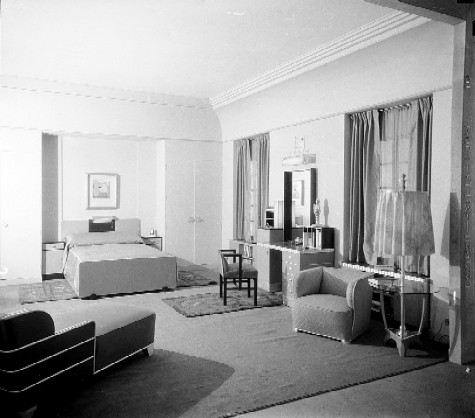
Space Conservation, Macy's International Exposition of Art in Industry, Living and
Bedroom Combination, K. E. M. Weber, 1928, Loc Gov
With the change in market focus came a need for specific products which would appeal to that market. Urban dwellers often lived in apartments and suburban dwellers in smaller homes than the wealthy Art Deco patrons of the 1920s. Some designers assembled multi-functional rooms for exhibitions in an effort to show how such furniture could be utilized in smaller habitations. K. E. M. Weber designed a small apartment for the Macy's International Exposition of Art in Industry held in 1928. As an article in a contemporary magazine explained,
The most extensive of the American groupings [at the Macy's Exposition] was a three-room , all modern apartment designed by Kem Weber of Los Angeles. Here we found a combination living room and bed room, with built-in cabinets and bookcases, and a very tricky combination of dressing table and desk. A very few pieces of modern sculpture and painting kept the room from being almost too austere in line and color combination." (N. C. Sanford, "An International Exhibit of Modern Art", Good Furniture Magazine, July, 1928, p. 18)
Furniture
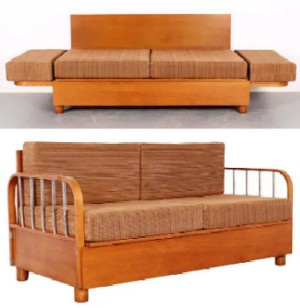
Space Conservation, Covertible Sofa, Fabric, Wood,
Chromed Metal, Jindrich Halabala, 1930s
designs were impacted. Furniture which took the best
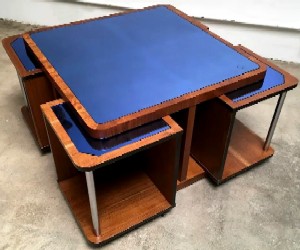
Space Conservation, Table with Four Small Nesting
Tables, Blue Mirror, Walnut Veneer, Chromed Steel
Supports, Paul Frankl, 1920s, Chairish
advantage of smaller spaces was required for these urban dwellers, resulting in the creation of multipurpose furniture and designs which could be folded or broken down and stored during this period took advantage of this.
It was an interesting relationship - Art Deco helped increase urbanization as young people moved to the cities to embrace the financial possibilities, freedom and style of living resulting in some interior designs which accomodated them. Although most furniture, particularly during the 1920s was designed to be anything but economical, select furniture and accessories were designed to fit in the smaller spaces as some of the space.conserving designs below suggest.
Original Facebook Group Posting
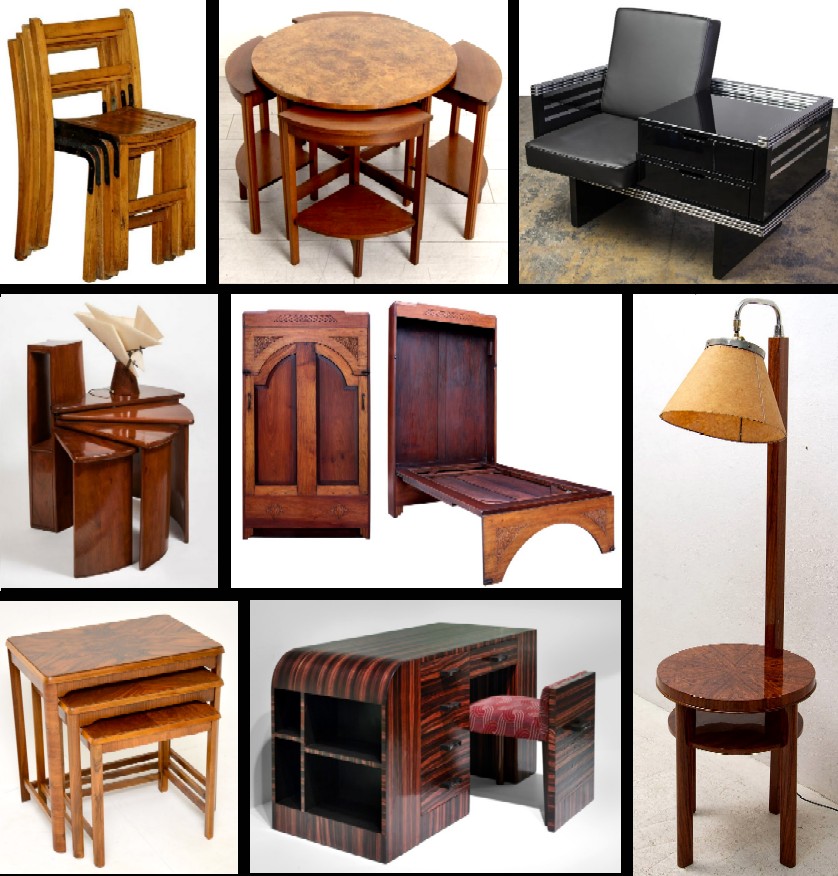 Space Conserving Furniture, from left - Stacking Chairs, English Oak, 1930s, 1st Dibs; Round Table with Four Nesting Quarter Tables, Walnut with Karelian Birch Top, 1930, Pamono; Arm Chair with Built in Side Table with Drawers, Glossy Black Lcquer Finish, Pearl Leather Uphostelry, Chrome Details, French, c. 1930s, Le Deco Style; Fanning Telephone Table with Nun Lamp, Walnut and Wrought Iron,Pierre Chareau, 1924, Art Deco Soceity of New York; Murphy Bed, 1930s, Invaluable; Side Table with Integrated Lamp, Walnut Veneer, Chromed Metal, Czechoslovakia, 1930s, IntOndo; Nesting Tables, Walnut, English, 1930s, Retrospective Interiors; Australian Walnut Desk with Integral Chair, Waterfall, Maurice Adams, c. 1935, The Wolfsonian
Space Conserving Furniture, from left - Stacking Chairs, English Oak, 1930s, 1st Dibs; Round Table with Four Nesting Quarter Tables, Walnut with Karelian Birch Top, 1930, Pamono; Arm Chair with Built in Side Table with Drawers, Glossy Black Lcquer Finish, Pearl Leather Uphostelry, Chrome Details, French, c. 1930s, Le Deco Style; Fanning Telephone Table with Nun Lamp, Walnut and Wrought Iron,Pierre Chareau, 1924, Art Deco Soceity of New York; Murphy Bed, 1930s, Invaluable; Side Table with Integrated Lamp, Walnut Veneer, Chromed Metal, Czechoslovakia, 1930s, IntOndo; Nesting Tables, Walnut, English, 1930s, Retrospective Interiors; Australian Walnut Desk with Integral Chair, Waterfall, Maurice Adams, c. 1935, The Wolfsonian